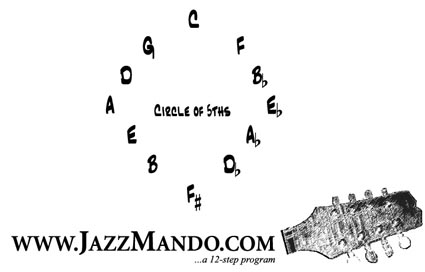JazzMando.com Tips and Tricks
At some point in your musical development, you have stumbled on to one of the great confounders of enharmonic notes in scales. Ab is G#, Gb is F#, etc... Most get that, but you run into the rebel that says "E# is equal to F? What's up with that. Why not just call it "F" and be done with it? Why waste brain cells adding an accidental to a perfectly good note when you don't have to?" This resentment runs deep especially in beginning piano players.
Aurally, it won't make a bit of difference (let's not get nit-picky about equal temperament for now). Physically, it's the same fingering on a mandolin fretboard, although we used to have fun in practice, joking about having to send that new mandolin back to the builder because it only came with Fs and no E#s. But if you're going to dip your toe into music theory (and we all do at some point), you need to embrace the E# (and B#) from a functional standpoint. An E# in a flat key is as out of place as a trombone at a Bluegrass festival.
When we start tripping around the Circle of 5ths, we get to that fuzzy part where keys with lots of sharps and lots of flats start intertwining. We want to make things simpler by thinking enharmonically, but you have to retain the function of the note, because of how it interacts with the other notes in the scale. If we are in the key of C# (seven sharps), and E# is an important note of the scale, the 3rd. It defines the "majorness" of the mode, and to call it an F natural would give it an entirely different scale degree function.
Here's an example of a chord progression recently transcribed in a set list, rather poorly:
C# Fm F# D#m
Here is a better version, notice the 2nd chord:
C# C#/E# F# D#m
Why is this better? It represents the chord's function in the rest of the piece in the context of C# Major. Note in the first example the chord is both aurally and enharmonically correct, but in a world of six sharps, it pulls a mental muscle. The chord is actually a first inversion major 7 tonic (3rd in the bass), and would be more accurately spelled this way:
C#Maj7/E#
Fm triad with then notes F Ab C could be thought of as the first inversion rootless C# Maj7 chord, E#, G#, B# (no C#), but in the circle of keys, it's a little like setting your clock from 5:35 to 5:30 by moving the hand forward 23 hours and 55 minutes, rather than moving it back 5 minutes.
And before you ask, we think C#/E# is simply better chord shorthand than C#Maj7/E# in the context of this song. The B# is unnecessary, though it fit the song better stylistically. It's like the swing musician throwing the obligatory Maj6 chord on a major triad. It goes with the territory.
Homework: Go mark all your F notes on your mandolin and tell them to be E#s.
Further:
Circle of Fifths
Accidental Indicators
Chromatic Equality and Justice for All (Keys)
Three Four Pull
Music geekdom. Tonal functions go clubbing
I hate music theory (Part 1)
Visit JazzMando.com web site...









 Reply With Quote
Reply With Quote
 Mixt Company
Mixt Company









 G# is the VIIb of the A# scale, the V tone of the A# scale is E#, and the A# chord is A# D E#. And the IV chord is D#. Otherwise ... OK.
G# is the VIIb of the A# scale, the V tone of the A# scale is E#, and the A# chord is A# D E#. And the IV chord is D#. Otherwise ... OK. 



Bookmarks